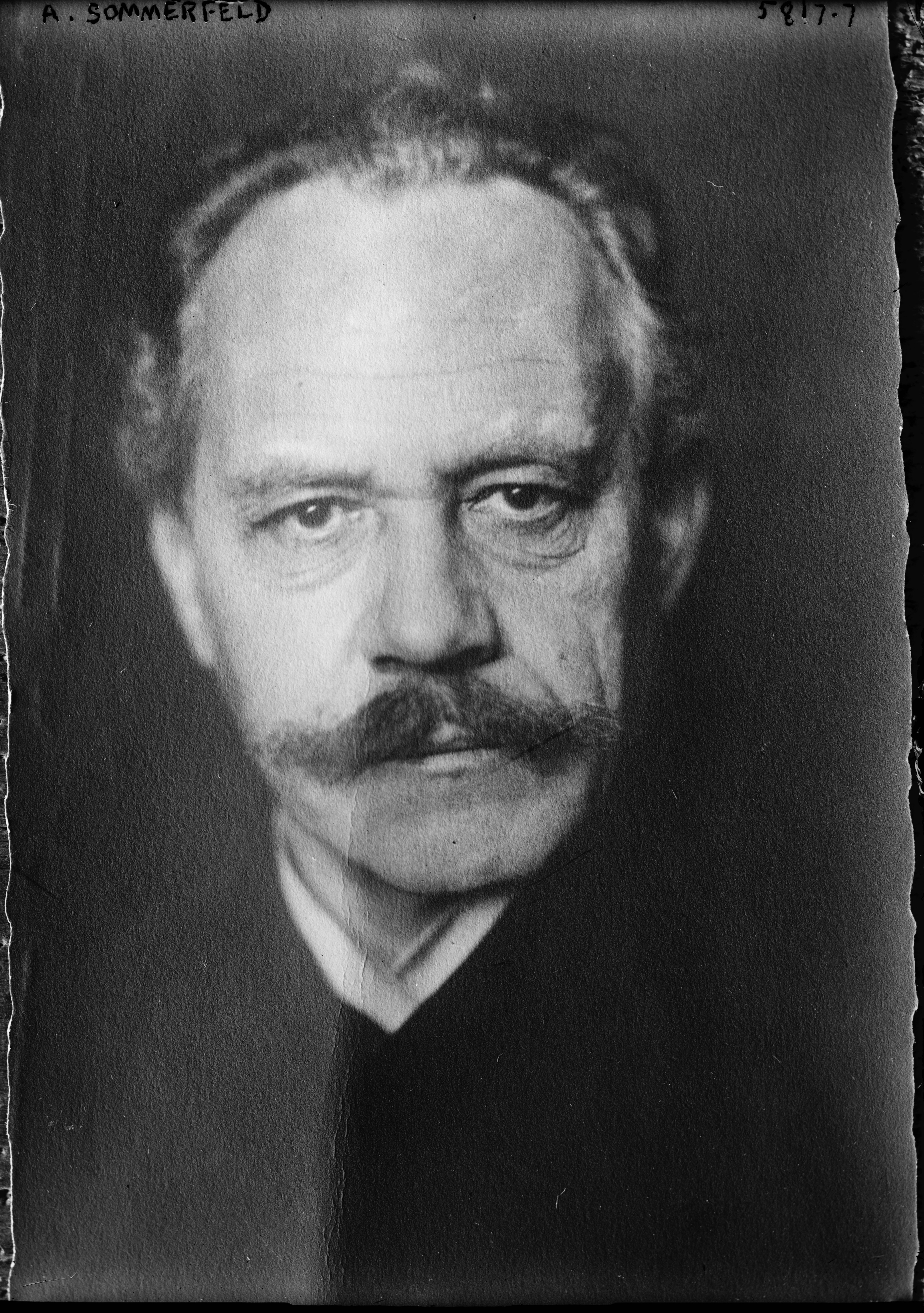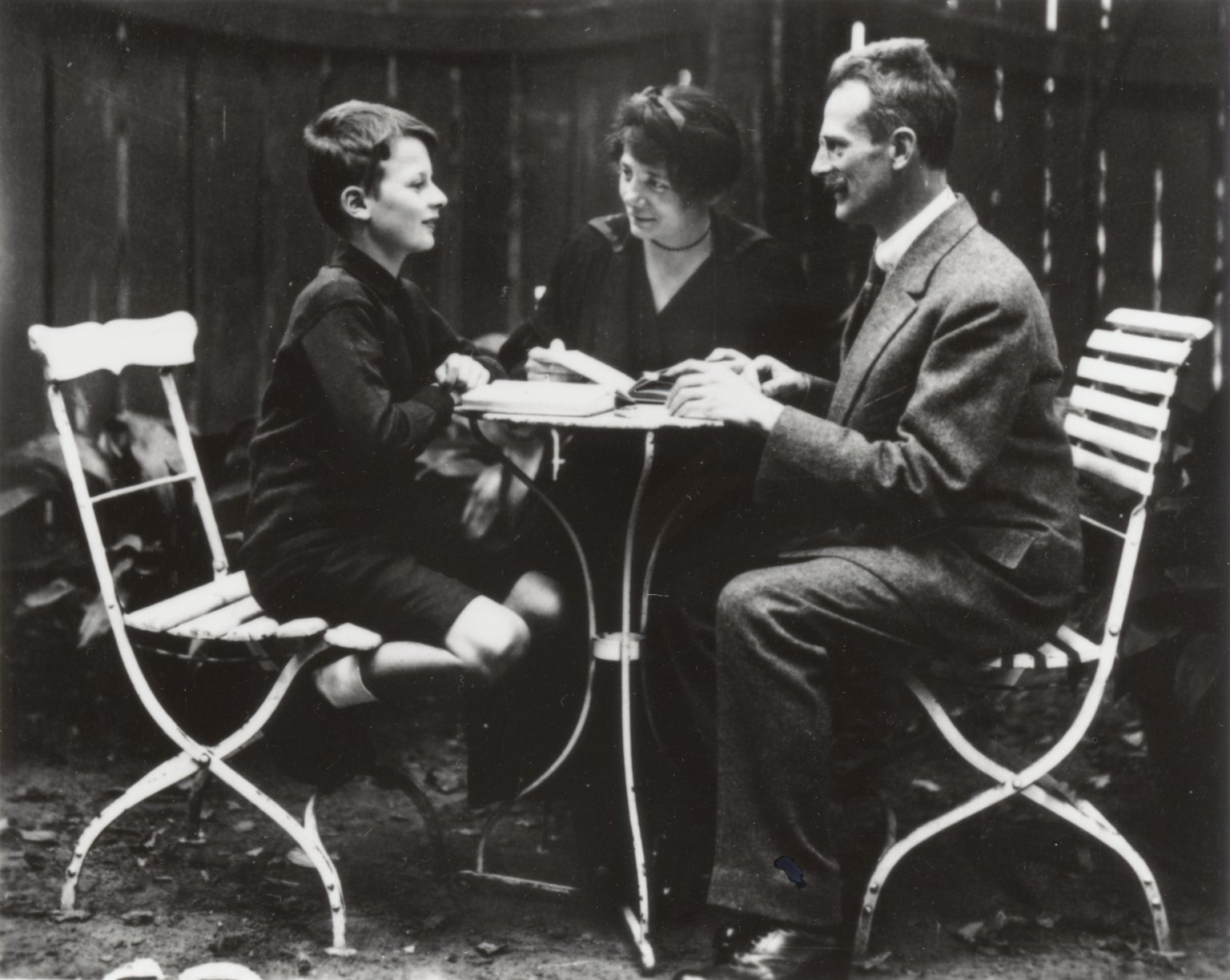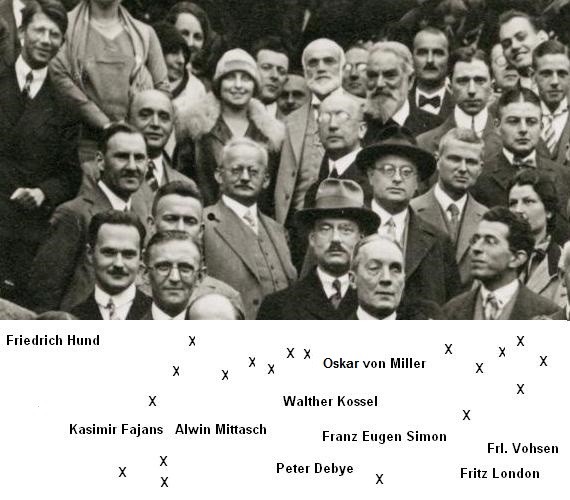|
Sommerfeld
Arnold Johannes Wilhelm Sommerfeld, (; 5 December 1868 – 26 April 1951) was a German theoretical physicist who pioneered developments in atomic and quantum physics, and also educated and mentored many students for the new era of theoretical physics. He served as doctoral supervisor for many Nobel Prize winners in physics and chemistry (only J. J. Thomson's record of mentorship is comparable to his). He introduced the second quantum number (azimuthal quantum number) and the third quantum number (magnetic quantum number). He also introduced the fine-structure constant and pioneered X-ray wave theory. Early life and education Sommerfeld was born in 1868 to a family with deep ancestral roots in Prussia. His mother Cäcilie Matthias (1839–1902) was the daughter of a Potsdam builder. His father Franz Sommerfeld (1820–1906) was a physician from a leading family in Königsberg, where Arnold's grandfather had resettled from the hinterland in 1822 for a career as Court Postal ... [...More Info...] [...Related Items...] OR: [Wikipedia] [Google] [Baidu] |
Paul Peter Ewald
Paul Peter Ewald, FRS (January 23, 1888 in Berlin, Germany – August 22, 1985 in Ithaca, New York) was a German crystallographer and physicist, a pioneer of X-ray diffraction methods. Education Ewald received his early education in the classics at the Gymnasium in Berlin and Potsdam, where he learned to speak Greek, French, and English, in addition to his native German.Ewald – Memorial Ewald began his higher education in , , and at |
Hans Bethe
Hans Albrecht Bethe (; July 2, 1906 – March 6, 2005) was a German-American theoretical physicist who made major contributions to nuclear physics, astrophysics, quantum electrodynamics, and solid-state physics, and who won the 1967 Nobel Prize in Physics for his work on the theory of stellar nucleosynthesis. For most of his career, Bethe was a professor at Cornell University.Available at www.JamesKeckCollectedWorks.or are the class notes taken by one of his students at Cornell from the graduate courses on Nuclear Physics and on Applications of Quantum Mechanics he taught in the spring of 1947. During World War II, he was head of the Theoretical Division at the secret Los Alamos National Laboratory, Los Alamos laboratory that developed the first atomic bombs. There he played a key role in calculating the critical mass of the weapons and developing the theory behind the implosion method used in both the Trinity test and the "Fat Man" weapon dropped on Nagasaki in August 1945. ... [...More Info...] [...Related Items...] OR: [Wikipedia] [Google] [Baidu] |
Werner Heisenberg
Werner Karl Heisenberg () (5 December 1901 – 1 February 1976) was a German theoretical physicist and one of the main pioneers of the theory of quantum mechanics. He published his work in 1925 in a breakthrough paper. In the subsequent series of papers with Max Born and Pascual Jordan, during the same year, his matrix formulation of quantum mechanics was substantially elaborated. He is known for the uncertainty principle, which he published in 1927. Heisenberg was awarded the 1932 Nobel Prize in Physics "for the creation of quantum mechanics". Heisenberg also made contributions to the theories of the hydrodynamics of turbulent flows, the atomic nucleus, ferromagnetism, cosmic rays, and subatomic particles. He was a principal scientist in the German nuclear weapons program during World War II. He was also instrumental in planning the first West German nuclear reactor at Karlsruhe, together with a research reactor in Munich, in 1957. Following World War II, he was appointed ... [...More Info...] [...Related Items...] OR: [Wikipedia] [Google] [Baidu] |
Helmut Hönl
Helmut Hönl (February 10, 1903 in Mannheim, Germany – March 29, 1981 in Freiburg im Breisgau) was a German theoretical physicist who made contributions to quantum mechanics and the understanding of atomic and molecular structure. Biography From 1921 to circa 1923, Hönl studied at the University of Heidelberg and the University of Göttingen, followed by the University of Munich, where he studied under Arnold Sommerfeld. He was granted his doctor of philosophy in 1926. In 1929, he became assistant to Paul Peter Ewald at the Stuttgart Technische Hochschule until 1933, after which he was a Privatdozent. 1940 he became extraordinary professor at the University of Erlangen and 1943 ordinary professor for theoretical physics at the University of Freiburg, where he emerited 1971. Even before acquiring his doctorate at Munich, Hönl had done seminal work which contributed to the advancement of quantum mechanics and the understanding of atomic and molecular structure and spectra ... [...More Info...] [...Related Items...] OR: [Wikipedia] [Google] [Baidu] |
Erwin Fues
Erwin Richard Fues (17 January 1893 in Stuttgart, Germany – 17 January 1970, Germany), was a German theoretical physicist who made contributions to atomic physics and molecular physics, quantum wave mechanics, and solid-state physics. Education and career During the period 1912 to 1914, Fues studied at the University of Berlin and then the University of Munich. He served in the military in 1914 to circa 1915, and then attended the University of Tübingen from 1916 to 1918. During 1918, he became a student of Arnold Sommerfeld and he received the ''doctor rerum naturalium'' from the University of Munich in 1920. From 1922 he did postgraduate work at the Stuttgart ''Technische Hochschule'', under Paul Peter Ewald, also a former student of Arnold Sommerfeld, and he completed his Habilitation in 1924. At Stuttgart he served as a ''Privatdozent'' and assistant to Ewald until 1929, during which time he worked on atomic and molecular structure and spectroscopy based on the Sommerfeld-B ... [...More Info...] [...Related Items...] OR: [Wikipedia] [Google] [Baidu] |
Walther Kossel
Walther Ludwig Julius Kossel (4 January 1888 – 22 May 1956) was a German physicist known for his theory of the chemical bond (ionic bond/octet rule), Sommerfeld–Kossel displacement law of atomic spectra, the Kossel-Stranski model for crystal growth, and the Kossel effect. Walther was the son of Albrecht Kossel who won the Nobel Prize in Physiology or Medicine in 1910. Career Kossel was born in Berlin, and began studies at the University of Heidelberg in 1906, but was at the University of Berlin during 1907 and 1908. In 1910, he became assistant to Philipp Lenard, who was also his thesis advisor. Kossel was awarded his Ph.D. in 1910, and he stayed on as assistant to Leonard until 1913. In 1913, the year in which Niels Bohr introduced the Bohr model of the atom, Kossel went to the University of Munich as assistant to Arnold Sommerfeld, under whom he did his Habilitation. Under Sommerfeld, Munich was a theoretical center for the developing atomic theory, especially from the ... [...More Info...] [...Related Items...] OR: [Wikipedia] [Google] [Baidu] |
Wilhelm Lenz
Wilhelm Lenz (February 8, 1888 in Frankfurt am Main – April 30, 1957 in Hamburg) was a German physicist, most notable for his invention of the Ising model and for his application of the Laplace–Runge–Lenz vector to the old quantum mechanical treatment of hydrogen-like atoms. Biography In 1906, Lenz graduated from the Klinger-Oberralschule, a non-classical secondary school in Frankfurt, and went to study mathematics and physics at the University of Göttingen. From 1908 to 1911, Lenz studied under Arnold Sommerfeld, at the University of Munich, and he was granted his doctorate on March 2, 1911. Upon graduation, he stayed on at the University, became Sommerfeld’s assistant on April 1, 1911, and he completed his Habilitation on February 20, 1914, becoming a Privatdozent on April 4, 1914. During World War I, he served as a radio operator in France and was awarded the Iron Cross Second Class in 1916. From September 30, 1920, he was again an assistant to Sommerfeld at the ... [...More Info...] [...Related Items...] OR: [Wikipedia] [Google] [Baidu] |
Alfred Landé
Alfred Landé (13 December 1888 – 30 October 1976) was a German-American physicist known for his contributions to quantum theory. He is responsible for the Landé g-factor and an explanation of the Zeeman effect. Life and achievements Alfred Landé was born on 13 December 1888 in Elberfeld, Rhineland, Germany, today part of the city of Wuppertal. In 1913 Landé was sent by Arnold Sommerfeld, his thesis advisor at the University of Munich, to be a special assistant for physics to David Hilbert at the University of Göttingen, to replace Paul Peter Ewald, whom Sommerfeld had sent to the same position in 1912. There, Landé also came in close contact with Max Born. In physics, it was the era of the Bohr atom model. The leaders of Göttingen science included many greats that Landé was to come in contact with including Hilbert, Edmund Landau, Carl Runge and Ludwig Prandtl (the noted aerodynamics theoreticist). Also Niels Bohr and Hendrik Lorentz visited Göttingen frequently. ... [...More Info...] [...Related Items...] OR: [Wikipedia] [Google] [Baidu] |
Hermann Brück
Hermann Alexander Brück CBE FRSE (15 August 1905 – 4 March 2000) was a German-born astronomer, who spent the great portion of his career in various positions in Britain and Ireland. Education Hermann Brück was born in Berlin. His father was Hermann Heinrich Brück and his mother, Margaret. Young Hermann was educated at the Kaiserin Augusta Gymnasium in Berlin-Charlottenburg, a school specialising in the Classics (Latin and Greek), where he also had excellent teachers in mathematics and physics. From 1924-28, Brück, was educated at the University of Kiel, the University of Bonn, and the Ludwig Maximilian University of Munich. His doctoral work on the wave mechanics of crystals was under the supervision of Arnold Sommerfeld. His interest in astronomy came early in life, and he turned his attention to astronomical spectroscopy. He was granted his PhD at Munich in 1928. [...More Info...] [...Related Items...] OR: [Wikipedia] [Google] [Baidu] |
Peter Debye
Peter Joseph William Debye (; ; March 24, 1884 – November 2, 1966) was a Dutch-American physicist and physical chemist, and Nobel laureate in Chemistry. Biography Early life Born Petrus Josephus Wilhelmus Debije in Maastricht, Netherlands, Debye enrolled in the Aachen University of Technology in 1901. In 1905, he completed his first degree in electrical engineering. He published his first paper, a mathematically elegant solution of a problem involving eddy currents, in 1907. At Aachen, he studied under the theoretical physicist Arnold Sommerfeld, who later claimed that his most important discovery was Peter Debye. In 1906, Sommerfeld received an appointment at Munich, Bavaria, and took Debye with him as his assistant. Debye got his Ph.D. with a dissertation on radiation pressure in 1908. In 1910, he derived the Planck radiation formula using a method which Max Planck agreed was simpler than his own. In 1911, when Albert Einstein took an appointment as a professor at Prague ... [...More Info...] [...Related Items...] OR: [Wikipedia] [Google] [Baidu] |
Karl Meissner
Karl Wilhelm Meissner (December 15, 1891 in Reutlingen, Württemberg – April 13, 1959 on a cruise ship sailing to Europe) was a German-American physicist specializing in hyperfine spectroscopy. He spent the greater part of his career in the United States at Purdue University, in West Lafayette, Indiana. Education After Meissner’s abitur at the ''Humanistisches Gymnasium'', in 1910, he began the study of physics and mathematics at University of Tübingen. After three terms, he went to the University of Munich as a student of the experimentalist Wilhelm Röntgen and the theoretician Arnold Sommerfeld. After one year at Munich, he returned to Tübingen to be able to study spectroscopy with Friedrich Paschen. While still a student in 1914, Meissner was able to prove the existence of oxygen lines in the solar spectrum. He was awarded his doctorate in 1915, on a thesis with the title ''Interferometrische Wellenlängenbestimmung im infraroten Spektralbereich''. In 1916 he ... [...More Info...] [...Related Items...] OR: [Wikipedia] [Google] [Baidu] |
Paul Sophus Epstein
Paul Sophus Epstein (; Warsaw, Vistula Land, Russian Empire, March 20, 1883 – Pasadena, California, United States, February 8, 1966) was a Russian-American mathematical physicist. He was known for his contributions to the development of quantum mechanics, part of a group that included Lorentz, Einstein, Minkowski, Thomson, Rutherford, Sommerfeld, Röntgen, von Laue, Bohr, de Broglie, Ehrenfest and Schwarzschild. Paul Epstein's parents, Siegmund Simon Epstein and Sarah Sophia (Lurie) Epstein were of a middle class Jewish family. He said that his mother recognized his potential at the age of four years and predicted that he would be a mathematician. He went to the Hochschule in Minsk, and from 1901-1905 studied mathematics and physics at the Imperial University of Moscow under Pyotr Nikolaevich Lebedev. In 1909 he graduated, and became a Privatdozent at the University of Moscow. In 1910 he went to Munich, Germany, to do research under Arnold Sommerfeld, who was his ad ... [...More Info...] [...Related Items...] OR: [Wikipedia] [Google] [Baidu] |



.jpg)


